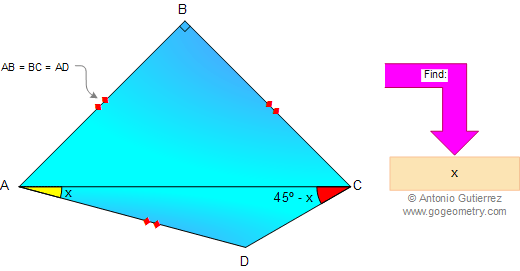This section requires Javascript.
You are seeing this because something didn't load right. We suggest you, (a) try
refreshing the page, (b) enabling javascript if it is disabled on your browser and,
finally, (c)
loading the
non-javascript version of this page
. We're sorry about the hassle.
3 solutions
Let A B = B C = A D = 1 . Then A C = A B 2 + B C 2 = 2 . We note that ∠ A D C = 1 8 0 ∘ − x − ( 4 5 ∘ − x ) = 1 3 5 ∘ . Using sine rule :
A D sin ∠ A C D 1 sin ( 4 5 ∘ − x ) sin ( 4 5 ∘ − x ) 4 5 ∘ − x ⟹ x = A C sin ∠ A D C = 2 sin 1 3 5 ∘ = 2 1 = 3 0 ∘ = 1 5 ∘
Join B to D. From Quad ABCD, we see that <ADC=135°. Larger <ABC = 270°. Moreover, because Tr. ABC is isosceles with BA=BC, B lies on the perpendicular bisector of AC as also Larger <ABC = 270°=2*(<ADC). Then, B is the circumcentre of Tr. ADC and BD=BA=BC=AD. In other words, Tr. BAD is equilateral and hence 45°+x=60° or x=15°

∠ A D C = 1 8 0 − x − ( 4 5 − x ) = 1 3 5 ∘
Extend C D to E such that E D ⊥ A E . Since ∠ A D C and ∠ A D E are supplementary angles, ∠ A D E = 1 8 0 − 1 3 5 = 4 5 ∘ . It follows that △ A E D is an isosceles triangle. By ratio and proportion, we have
1 A E = 2 1 ⟹ A E = 2 2 , since A C is twice A E , △ A E C is a 3 0 − 6 0 − 9 0 special right triangle. It means that ∠ A C D = 3 0 ∘ .
Finally, 4 5 − x = 3 0 or x = 1 5 ∘